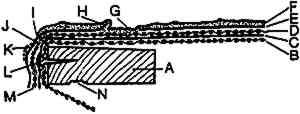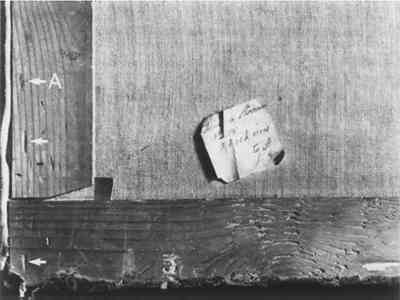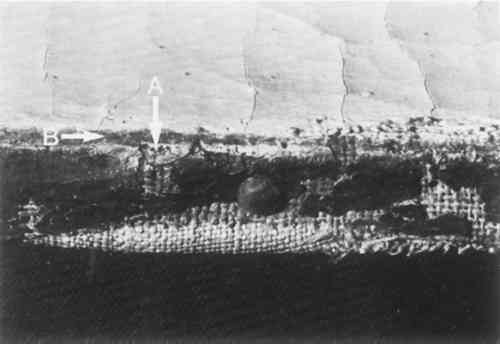AN 18TH-CENTURY ARTIST-APPLIED LINING: JOSEPH WRIGHT OF DERBY'S CUT THROUGH THE ROCK AT CROMFORDIAN S. HODKINSON, & DEBORAH M. CHILD
3 TECHNICAL ANALYSESAlthough the focus of this study is Cromford, the technical analysis of Derwent will be discussed first, as it is more typical of Wright's painting practices and therefore highlights the unusual characteristics of the other work. 3.1 DERWENT3.1.1 AUXILIARY SUPPORT, WOOD STRAINERDerwent is supported on a wooden strainer (i.e., a stretching frame with fixed corner joints), consisting of four members made of pine with a cross section, 11 � 32 mm, chamfered on the inner edge. (Fixed-joint stretchers are often referred to as “strainers,” but this seems a dubious distinction since the action of keying out a painting on a stretcher with expandable joints would actually put more “strain” on the painting in the mechanical sense.) They are joined at the corners, slightly off the square, with half-lap joints glued with animal glue and nailed with hand-forged nails clinched on the side toward the canvas (Neve 1726). This method seems typical of the period and would conform to the shape of the profile on the back of Mr. and Mrs. Coltman as described by Wyld and Thomas (1986). It is also in the same form as the original strainer on an oil sketch of Hector's Farewell to Andromache (oil on canvas, 32.5 � 45.5 cm) by Gavin Hamilton, dated on the back 1792, in the Collection of I. Hodkinson. One refinement that Wright practiced was to cover the clinched ends of the nails with what appears to be a white lead putty to prevent their corrosion from affecting the canvas. The putty was first noticed in a radiograph and confirmed by removing the tacks at one corner and peering in. 3.1.2 ATTACHMENT OF CANVASThe tacks employed to attach the canvas to the stretcher are also of hand-forged iron and are approximately 7.5 mm long. The shapes of the heads vary. Some are irregularly shaped, and some have round heads similar to those used by upholsterers. They are of the type known as “white tacks,” that is, they were tinned to prevent corrosion (Neve 1726). The intervals between the tacks vary slightly, the average being 4.6 cm. The disposition of the 3.1.3 PRIMARY SUPPORT, CANVASThe canvas is in reasonably good condition, and while not floppy, it is not under tension on the stretcher. It is of linen 1 � 2 twill and has a selvage along the bottom, while the other three edges are cut. The average thread count is approximately 20 per cm vertical (i.e., weft) by 15 per cm horizontal (warp). The wale runs diagonally from bottom left to top right. The threads are irregularly spun, and although the weave is fairly tight, where there are adjacent thin threads there are open interestices visible from the back. 3.1.4 PREPARATION AND GROUNDThrough these interstics it is possible to see the sizing and ground. The sizing is of sufficient quantity to bridge the gaps and prevent the ground from penetrating the interstices. It is apparent that the canvas was sized and grounded in a larger piece of which this is only a section. At the selvage the ground does not continue to the very edge, and there are other tack holes with corresponding marked cusping. On the other three edges the ground continues right to the cut edges, and no cusping is visible. A sample cross section of ground and paint layers was mounted and examined, and a smooth, creamy white ground containing some larger translucent particles was noted similar to those illustrated by Jones (1990). 3.1.5 UNDERDRAWINGOn visual examination, there appeared to be graphite delineation of the mountain contour. The presence of underdrawing was confirmed by infrared vidicon examination. Of the 50 Wright paintings examined by Jones (1991a), underdrawing was visible in only one work: View in Matlock Dale(Egerton 1990). As both paintings are of the same local scene, perhaps Wright began them both plein air using graphite directly on the prepared canvas. 3.1.6 PAINT LAYERSThe painting was done after the canvas was mounted on the stretcher, as the strokes of paint seen on some tack heads are of the same color as the adjacent painting where the brush hairs have gone partly over the edge. The cross-section examination confirms that the dead coloring is noticeable under the landscape. The paint application is vigorous but controlled. Both finger and brush have been used in creating the heavier texture on the sky. Ultraviolet examination shows that a grayish glaze was applied between the trees and the contours of the mountain to mute the brightness of the sky while giving it luminosity and re-establishing recession in space. The fine craquelure relates more to the weave geometry of the canvas than to stresses induced by tension from stretching. 3.1.7 SURFACE COATINGThere is a surface coating on the painting, but because of significant differences in crackle pattern between the varnish and the painting it is believed that it is not artist-applied. 3.2 CROMFORDTo assist in understanding the structure a cross-sectional diagram is shown in figure 7.
3.2.1 AUXILIARY SUPPORT, WOOD STRETCHERThe four-membered stretcher is quite sophisticated. It is made of pine, each member approximately 6.0 cm wide and 1.4 cm thick at the perimeter. There is a slight overall bevel, the inner edge being 2–3 mm thinner. Of the three original stretchers identified by Jones (1991a), two of them are similar in design, but no description was given of the type of corner joint. The corner joints on Cromford are of an expandable, mortise-and-tenon type, with the tenons of haunched design to minimize warping and slitting (fig. 7) and with provision for
3.2.2 SECONDARY CANVAS SUPPORT AND ATTACHMENTThe painting is lined on a linen canvas having a thread count of 12.5 per cm (horizontal) and 16 per cm (vertical). This lining fabric is attached to the stretcher with tacks independently from the primary canvas support (i.e., the tacks are under the tacking edge of the painting), indicating that it was on the stretcher prior to adhering the painting. The tinned tacks are of the same type as those used for attachment of the painting and are similar to those noted above on Derwent but with a higher proportion of the round-headed variety. The adhesive is of a paste type and has a light grayish white appearance. It tests strongly for starch with the iodine/potassium iodide test (Browning 1977). Tests for protein were inconclusive when using fluorochrome stains (Wolbers and Landrey 1987). Subsequent instrumental analysis with Fourier transform infrared spectroscopy (FTIR) confirmed that it is a starch and protein adhesive (Moffat and Miller 1991). 3.2.3 PRIMARY CANVAS SUPPORT AND ATTACHMENTThis plain-weave, flax canvas has a thread count of 10.5 � 10.5 threads per cm. The canvas is brown and brittle, much more so than any of the other six canvases in the Queen's University group. There is an unpainted tacking edge at the right, but the other three edges show that it has been cut from a larger, already painted canvas. The tacks used to attach this canvas are the same as those employed on the lining canvas. 3.2.4 PREPARATION AND GROUNDSince the painting is lined it is difficult to determine if the canvas was sized, but normal practice would suggest so. Cross-section examination shows that the ground is substantial, with a dull pink color and finely ground pigments. A pink ground is unusual for Wright. The other indisputable Wrights in the Queen's University group all have creamy white grounds of the same general type as shown in the seven cross sections illustrated by Jones (1990). Of the 50 Wright paintings Jones examined in preparation for the technical section of the Tate exhibition, 14 of which were cross sectioned, only two were found to have pink grounds: the Portrait of Brooke Boothby dating from 1781 and Cottage on Fire, c. 1790, in the Derby Art Gallery (Jones 1991b). The density of the ground in the radiograph suggests a high lead white content, which unfortunately also prevented any further interpretation concerning the earlier composition. At the top left quadrant the ground has flaked considerably, to the extent that in two places the canvas is covered only by the paint of the later painting. Flakes of ground and paint are embedded in the new paint, indicating that the damage was present when Wright's sky color was applied. 3.2.5 PAINT LAYERSAs noted above, this painting was completed over a fragment of an earlier composition. Thus, there are two quite distinct stratifications present. The earliest consists of thin layers that were applied with quite fluid paint in a generally reddish brown hue no doubt influenced by the color of the ground. This earliest presentation surface is visible not only at the bottom right corner encompassing the figure group but also on the bottom, top, and left tacking edges. The right edge corresponds with the present edge and, to judge from the cusping, the bottom seems to have been displaced by perhaps only a centimeter. However, there are no indications at the left and top of the dimensions of the earlier work. The second paint layer system is that of Wright. Since it lies only on the front surface and was not intended to carry around onto the tacking margins, it was definitely applied after the canvas was lined and mounted on its stretcher. The painting has remained undisturbed on this stretcher since it left Wright's hand. This is clearly shown by the presence of traces of Wright's paint on the tacking edges, where some of the bristles of his brush went over the edge and inadvertently deposited paint where the round-headed tacks of the lining canvas have caused bulges in the earlier paint surface on the tacking margin (fig. 10). X-radiography revealed that craquelure exists in the earlier paint layers but is not visible on the surface. At the top left, Wright's sky color penetrates some of these cracks. Therefore, the earlier painting was considerably aged and damaged before Wright used it.
|


